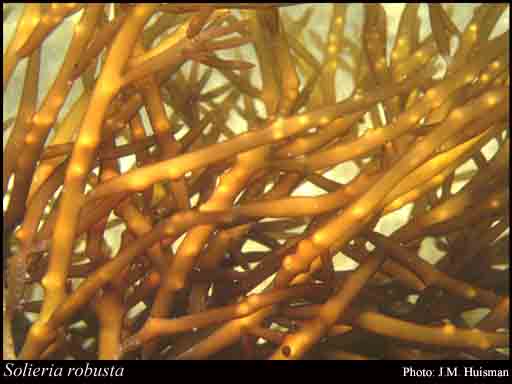- Reference
- Acta Univ.Lund. ser. 2, 28(8):18 (1932)
- Conservation Code
- Not threatened
- Naturalised Status
- Native to Western Australia
- Name Status
- Current

Scientific Description
Habit and structure. Thallus grey-red to brown-red, often bleached to yellow-grey, erect, 10–30 cm high, moderately and irregularly branched at intervals of 1–4 cm, branches relatively soft, terete to slightly compressed, (1–)2–5 mm in diameter, basally constricted and tapering above to rounded or sub-acute tips. Holdfast fibrous, branched, 1–2 cm across, with several fronds; epilithic. Structure multiaxial, with 5–15 apical cells, each subapical cell cutting off a single periaxial cell with successive periaxials orthostichous, developing a broad medulla of mainly longitudinal slender filaments connected by short lateral filaments and with abundant rhizoids, and a pseudoparenchymatous cortex 5–6 cells thick, inner cells irregularly ovoid with numerous secondary pit-connections, 30–80 µm in diameter, outer cells 8–14 µm in diameter and L/D (1–)1.5–2.5. Rhodoplasts elongate to ribbon shaped, several per cell.
Reproduction. Sexual thalli dioecious; non-procarpic. Carpogonial branches 3(–4)-celled, borne on an inner cortical cell and directed inwards, with a reflexed trichogyne, rarely with a sterile cell on the hypogynous cell. Connecting filament usually unbranched, non-septate (apart from adjacent to the carpogonium), uniting with the auxiliary cell in a darker staining complex (visible prior to, or at least soon after, diploidization) of cortical cells, with adjacent cells cutting off branched chains of cells which contribute to the pericarp. Gonimoblast initial first developed inwardly and producing a compact group of cells, later gonimoblasts developed radially from the enlarging fusion cell with terminal (and later subterminal), ovoid, carposporangia 15–25 µm in diameter and with some sterile gonimoblast filaments connected to the pericarp. Cystocarps single to clustered, immersed in the medulla and swelling the branch, with well-developed enveloping tissue of ovoid cells, ostiolate. Spermatangia scattered on young branches, cut off from surface cortical cells, ovoid to tapering, 2–3 µm in diameter. Tetrasporangia scattered in the outer cortex, basally attached, ovoid, 30–45 µm long and 25–32 µm in diameter, zonately divided.
Distribution.Recorded from Mauritius, South Africa, India, and the Philippines. Dongara, W. Aust., around southern Australia and Tas to Townsville, Qld. Lord Howe I.
Habitat. S. robusta is a common alga under moderate to fairly turbulent water movement, extending from sheltered areas with strong current flow to shallow to deep water on rough-water coasts.
[After Womersley, Mar. Benthic Fl. Southern Australia IIIA: 340–343 (1994)]
Distribution
- IBRA Regions
- Avon Wheatbelt, Dampierland, Jarrah Forest, Swan Coastal Plain.
- IBRA Subregions
- Merredin, Perth, Pindanland, Southern Jarrah Forest.
- IMCRA Regions
- Abrolhos Islands, Canning, Central West Coast, Kimberley, Leeuwin-Naturaliste, Pilbara (offshore), Shark Bay, WA South Coast.
- Local Government Areas (LGAs)
- Albany, Broome, Cockburn, Cottesloe, Dandaragan, Esperance, Fremantle, Greater Geraldton, Irwin, Karratha, Mandurah, Morawa, Northampton, Rockingham, Shark Bay.